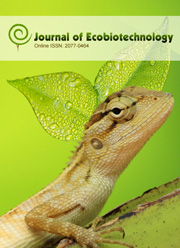Efficacy of Helicoverpa armigera Larvae on Conventional and Genetically Modified (Bollgard®) Cotton plants from Marathwada Region (MS) India
Abstract
Present study was conducted to evaluate cotton bollworm larval behaviour on Bollgard® cotton plants compared to conventional plants (Non-Bollgard®) and to determine their preferred feeding sites. Data from these studies conducted during pre-flowering and flowering stages are presented. The movement of Helicoverpa armigera was different on Bollgard® cotton plants compared to conventional cotton plants at all rating intervals. Cotton plant type (F=25.47; df=1,10; P<0.01) and time of evaluation (F=54.15; df=3,30; P<0.01). In pre-flowering cotton plants, bollworm larvae moved significantly more on individual flowering Bollgard® plants compared to conventional plants. Cotton plant type (F=41.70; df=1,10; P<0.01), time of evaluation (F=6.79; df=3,30; P<0.01), and the cotton plant type by time of evaluation interaction (F=3.63; df=3,30; P=0.02) was significant for percentages of larvae recovered from sticky traps. The study reports that current scouting protocols and action levels to initiate insecticide treatments for bollworms on non-Bollgard cotton plant are not appropriate for Bollgard® cotton plant. Scouts should look at white flowers and small bolls in addition to terminals and squares when scouting Bollgard® cotton plant because bollworm larvae migrate to those structures in a relatively short time.






 .
.